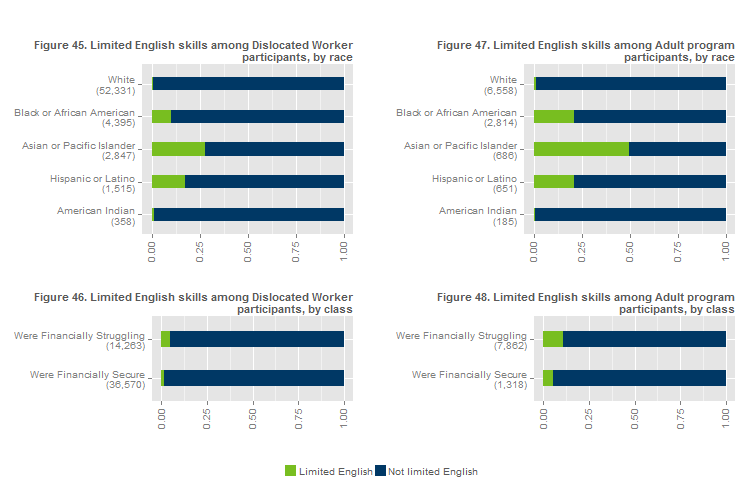Figures 45 through 48 show rates of limited English proficiency among participants. Language skills clearly exist on a continuum, and no formal definition of what constitutes limited proficiency exists at the state level.

Significant percentages of Asian or Pacific Islander participants in both Dislocated Worker and Adult programs have limited English skills. Over a quarter of Asian or Pacific Islander Dislocated Worker participants have limited English skills (Figure 45). Fully half of Asian or Pacific Islander participants in the Adult programs have limited English skills (Figure 47).
Smaller proportions of Black or African American and Hispanic or Latino participants have limited English skills, and white and American Indian participants have very low rates of limited English skills.
Differences in limited English skills by class are less stark but still present among both program populations: financially struggling participants in both programs have higher rates of limited English skills (Figure 46 and Figure 48).
Having limited English skills is itself a barrier to employment, but it also signals the possibility of related barriers having to do with immigration, such as limited comfort navigating the job search process in this country and limited awareness of job search and training resources available (See Note 1).
Multiple program managers reported having a network of employers who hire those with limited English skills. For example, when asked whether she sees promoting entrepreneurship as a way to reduce disparities, Rebekah Tedrick-Moutz, Teocalli Tequiotl Latino Academy Manager at the Latino Economic Development Center, said:
"Yes, because you get more people of color in management. And they come back and hire from our workforce clients. So you no longer have to wait until you're fluent in English even for a sales job or a tax preparer's job."
Diane Heldt, Senior Director of Employment Training Services at Lifetrack Resources, reported having a similar network of former immigrant participants in managerial roles who are now in the position to hire current participants with limited English skills.
Over 60% of counselor respondents report working with program applicants who have limited English skills. By far the most common accommodation was to provide translation services, whether from professional translators, from staff who know the language needed, or from LanguageLine, a company that provides interpretation over the phone.
About 10% of counselors who report working with applicants who have limited English skills also report that they must refer the person to language learning resources before they can enroll the person in these programs, suggesting limited English skills are not just a barrier to employment but can also be a barrier to participating in these programs.